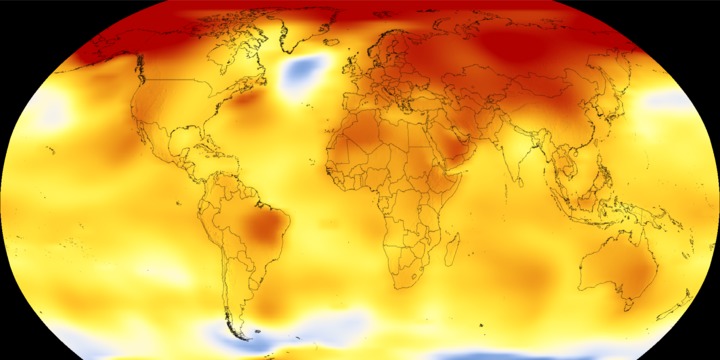Global surface temperature anomaly
Global surface temperature anomalies are a description of how the overall average temperature of the surface of the Earth deviates from what is expected. The value is obtained by measuring the average water temperature of the first few meters below the surface of the ocean and the temperature between the land surface and 1.5 meters above. This measurement is then compared to what is expected based on past measurements.[1] This measurement is closely linked to land surface air temperature, which looks only at temperatures above land. Anomalies are measured by the number of degrees that the temperature varies from the average.[2] A positive anomaly means temperatures were warmer than a reference value, while negative anomalies are cooler than that reference value.[3] The world has been showing a frightening abundance of positive anomalies in the past decade, which means the world is getting warmer. Figure 1 shows a map of temperature anomalies around the world in 2017.

Why Use Anomalies?
There are several reasons that anomalies are used to measure global surface temperature instead of absolute temperature. First, absolute estimates of average surface temperature are very challenging to obtain. Uneven distribution of temperature measurement stations worldwide and large amounts of interpolation for data-sparse regions leads to a large degree of uncertainty in these absolute measurements. As well, measurements in mountainous regions are impacted drastically by elevation and the time of year measurements are taken.[3] To avoid these uncertainties, anomalies are calculated using reference values computed on more local scales to show whether temperatures in a certain small region were above or below average.
Secondly, anomalies show how temperature is changing over time. By showing whether temperatures are below or above normal, anomalies describe how climate is changing over larger areas more clearly than absolute temperatures. A certain absolute temperature may be normal in one region of the globe, it could be above average in another. Anomalies remove this uncertainty in what is "normal" and present data that shows how temperature is deviating locally.[3]
Trends
To establish a baseline, between 1961 and 1990 the average temperature around the globe was approximately 14.0°C according to the World Meteorological Organization.[5] In 2016, the temperature anomaly was measured to be 0.99°C warmer than the historical average, making it the hottest year on record - with the data going back to 1880.[6] (For some interesting visualizations of time series global surface temperature data, click here).
Figure 2. A time-lapse video showing sixty years of global warming. Note how as the years progress the average temperature all over the globe increases and the image becomes more red.[7]
It is important to note that 2016, while the hottest year on record, was well within what climate change models predict. The 18 warmest years on record have all occurred since 1998, a clear indication of a trend.[6] Additionally, the average surface temperature is projected to rise continually over the next hundred years.[8] Trends worldwide show an overall increase in global surface temperatures - a change that can be attributed to the global warming occurring as a result of fossil fuel combustion and the release of greenhouse gases into the atmosphere.[8]
For more details on temperature anomalies, by region, by month or by year please see NOAA's website.
For Further Reading
- Temperature
- Water
- Greenhouse gas
- Global warming
- Climate
- Or explore a random page
References
- ↑ Dictionary of the Climate Debate. (October 17, 2015). Global Surface Temperature [Online]. Available: http://www.odlt.org/dcd/ballast/global_surface_temperature.html
- ↑ IPCC, 2012: Glossary of terms. In: Managing the Risks of Extreme Events and Disasters to Advance Climate Change Adaptation [Field, C.B., V. Barros, T.F. Stocker, D. Qin, D.J. Dokken, K.L. Ebi, M.D. Mastrandrea, K.J. Mach, G.-K. Plattner, S.K. Allen, M. Tignor, and P.M. Midgley (eds.)]. A Special Report of Working Groups I and II of the Intergovernmental Panel on Climate Change (IPCC). Cambridge University Press, Cambridge, UK, and New York, NY, USA, pp. 555-564.
- ↑ 3.0 3.1 3.2 NOAA. (October 18, 2015). Global Surface Temperature Anomalies [Online]. Available: https://www.ncdc.noaa.gov/monitoring-references/faq/anomalies.php
- ↑ Global Climate Change NASA. (October 7th, 2018). Data Visualizations [Online]. Available: http://climate.nasa.gov/vital-signs/global-temperature/
- ↑ University Corporation for Atmospheric Research. (October 18, 2015). What is the Average Global Temperature Now? [Online]. Available: https://www2.ucar.edu/climate/faq/what-average-global-temperature-now
- ↑ 6.0 6.1 NASA Global Climate Change. (October 18, 2015). Global Temperature [Online]. Available: http://climate.nasa.gov/vital-signs/global-temperature/
- ↑ The data are from NASA, here, but this file is on youtube. This was accessed October 7th, 2018.
- ↑ 8.0 8.1 US EPA. (October 18, 2015). Global Warming Basics [Online]. Available: http://www3.epa.gov/climatechange/basics/

